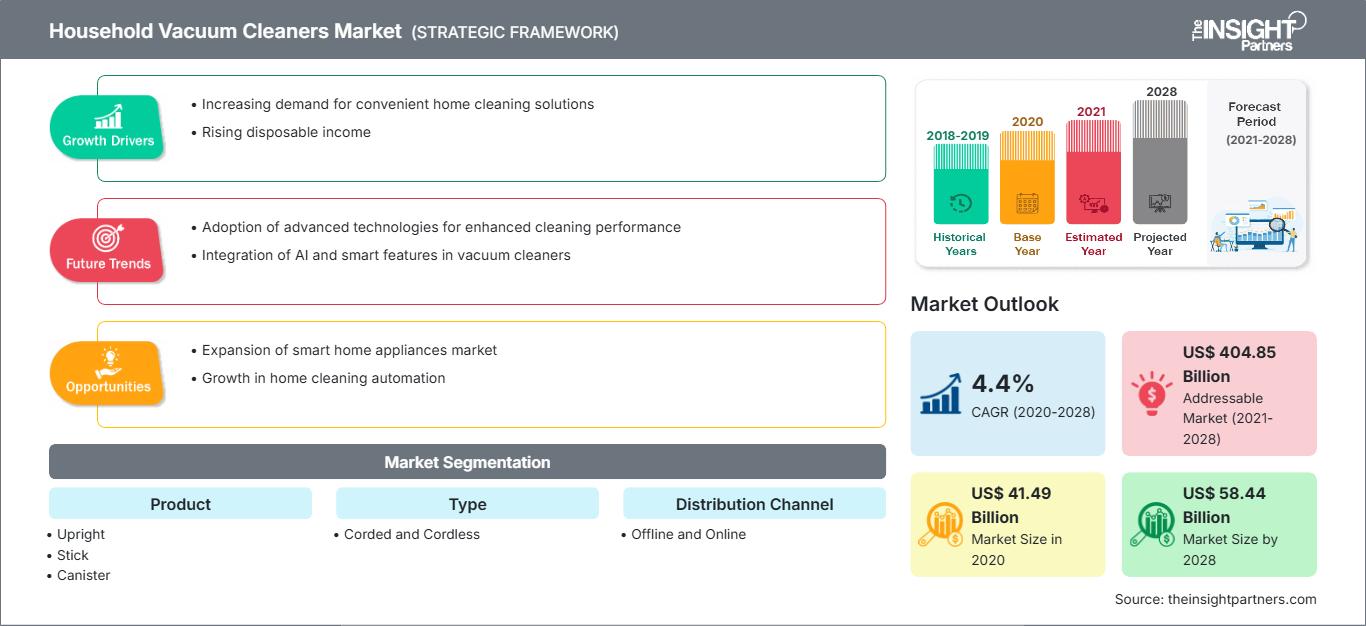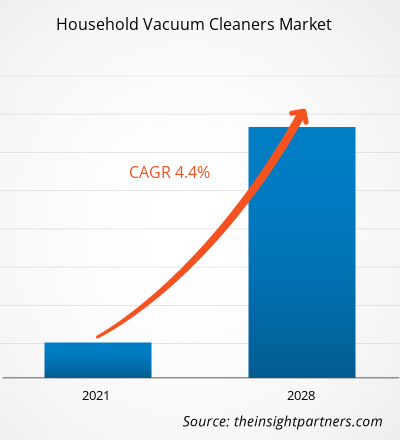Il mercato degli aspirapolvere domestici è stato valutato a 41.490,9 milioni di dollari nel 2020 e si prevede che raggiungerà i 58.439,6 milioni di dollari entro il 2028; si prevede una crescita a un CAGR del 4,4% dal 2021 al 2028.
Gli aspirapolvere domestici sono elettrodomestici, utilizzati per pulire e rimuovere detriti da pavimenti, tappezzerie, tendaggi e altre superfici mediante l'aspirazione. Gli aspirapolvere domestici sono disponibili in varie dimensioni e forme, nonché in diversi tipi di modelli, tra cui verticali, a traino, portatili e robotizzati, tra gli altri. Per offrire praticità, facilità d'uso e una pulizia efficiente, gli aspirapolvere domestici sono disponibili anche senza fili, rendendoli portatili e adatti alla pulizia di diverse aree della casa.
L'Asia-Pacifico è la regione dominante e in più rapida crescita per il mercato degli aspirapolvere domestici nel periodo di previsione. Questa regione è il centro dei principali produttori di aspirapolvere domestici come Eureka Forbes, Haier, Dyson e Koninklijke Philips NV, che offriranno diverse opportunità di crescita per il mercato degli aspirapolvere domestici nell'area Asia-Pacifico. I ritmi frenetici della vita lavorativa e le lunghe ore di lavoro hanno aumentato la domanda di elettrodomestici intelligenti, che ridurranno lo sforzo manuale delle famiglie nello svolgimento delle faccende domestiche. Parallelamente, il passaggio delle preferenze dei consumatori dai metodi di pulizia tradizionali a un approccio più moderno sta guidando la crescita del mercato degli aspirapolvere domestici nell'area Asia-Pacifico. L'aumento del reddito disponibile e la rapida urbanizzazione della regione stanno trainando il mercato degli aspirapolvere domestici nell'area Asia-Pacifico. Insieme alla preferenza dei consumatori per un approccio di pulizia modernizzato, la crescente consapevolezza relativa all'igiene domestica e la crescente tendenza all'automazione nelle attività quotidiane per risparmiare tempo stanno offrendo opportunità redditizie per il mercato degli aspirapolvere domestici in Asia-Pacifico.
La pandemia di COVID-19 ha drasticamente alterato lo stato del mercato degli aspirapolvere domestici. L'epidemia ha ridotto l'efficienza operativa e interrotto le catene del valore a causa dell'improvvisa chiusura dei confini nazionali e internazionali, causando così perdite di fatturato e danni. Le interruzioni nella catena del valore hanno limitato l'approvvigionamento di materie prime, il che, a sua volta, sta ostacolando la crescita del mercato e influenzando lo sviluppo delle industrie di utilizzo finale. Tuttavia, poiché le economie stanno pianificando di riprendere le loro attività, si prevede che la domanda di aspirapolvere domestici aumenterà a livello globale nei prossimi mesi. L'epidemia di COVID-19 ha sottolineato l'importanza delle pratiche di pulizia e igiene tra la popolazione. Secondo un corso di microapprendimento del Centro Europeo per la Prevenzione e il Controllo delle Malattie, è stato dimostrato che le particelle del virus SARS-CoV-2 possono essere trasportate dall'aria e depositarsi su altre superfici. Pertanto, la pulizia dei pavimenti diventa essenziale. Per questo motivo, Oreck offre aspirapolvere portatili e a traino, leggeri, portatili e dotati di un'aspirazione potente e di qualità superiore per eliminare facilmente lo sporco dalle stanze. Alcuni aspirapolvere a traino Oreck sono dotati di filtrazione HEPA per catturare e intrappolare polvere, sporco e altri allergeni, impedendo che lo sporco venga rilasciato nuovamente in casa. Passare l'aspirapolvere non eliminerà il SARS-CoV-2, ma renderà difficile per le particelle del virus diffondersi nell'aria, dove possono essere inalate o trasportate su superfici frequentemente toccate. Tuttavia, passare l'aspirapolvere può comunque ridurre significativamente la quantità di virus catturando e trattenendo detriti, polvere e altre particelle. Si prevede che tutti questi fattori aumenteranno la domanda di aspirapolvere domestici a livello globale nei prossimi anni.
Personalizza questo rapporto in base alle tue esigenze
Potrai personalizzare gratuitamente qualsiasi rapporto, comprese parti di questo rapporto, o analisi a livello di paese, pacchetto dati Excel, oltre a usufruire di grandi offerte e sconti per start-up e università
Mercato degli aspirapolvere domestici: Approfondimenti strategici

- Ottieni le principali tendenze chiave del mercato di questo rapporto.Questo campione GRATUITO includerà l'analisi dei dati, che vanno dalle tendenze di mercato alle stime e alle previsioni.
Approfondimenti di mercato: crescente preferenza per gli aspirapolvere per il mantenimento dell'igiene
Potrai personalizzare gratuitamente qualsiasi rapporto, comprese parti di questo rapporto, o analisi a livello di paese, pacchetto dati Excel, oltre a usufruire di grandi offerte e sconti per start-up e università
Mercato degli aspirapolvere domestici: Approfondimenti strategici

- Ottieni le principali tendenze chiave del mercato di questo rapporto.Questo campione GRATUITO includerà l'analisi dei dati, che vanno dalle tendenze di mercato alle stime e alle previsioni.
Pulire le case manualmente è sempre stato un metodo convenzionale per mantenere l'igiene e la pulizia in casa. Tuttavia, le case possono essere pulite in modo più efficace e in molto meno tempo con l'aiuto degli aspirapolvere domestici, rispetto ai metodi di pulizia tradizionali. Tuttavia, la necessità di aspirapolvere in casa non si limita oggi solo alla pulizia, poiché questi dispositivi vengono considerati anche per mantenere l'ambiente privo di germi. Gli aspirapolvere non solo offrono mezzi migliori e più efficaci per pulire i pavimenti, ma purificano anche l'aria. Le aziende stanno investendo in ricerca e sviluppo per introdurre nuovi aspirapolvere domestici con tecnologie avanzate per i motori, al fine di migliorare ulteriormente l'efficienza energetica e le prestazioni della macchina. Ad esempio, a settembre 2019, Miele ha annunciato il suo nuovo aspirapolvere domestico senza fili con filtri HEPA (High Efficient Particulate Absorbing) integrati. I filtri HEPA migliorano significativamente la qualità dell'aria interna e riducono il rischio di allergie e asma prevenendo il rilascio di inquinanti nell'aria. Di conseguenza, la crescente preferenza per gli aspirapolvere domestici per il mantenimento dell'igiene sta stimolando la crescita del mercato.
Approfondimenti sulla tipologia
In base alla tipologia, il mercato degli aspirapolvere domestici è segmentato in con e senza filo. Nel 2020, il segmento degli aspirapolvere con filo ha dominato il mercato degli aspirapolvere domestici. Gli aspirapolvere con filo offrono un'elevata potenza di aspirazione poiché sono collegati alla rete elettrica. Gli aspirapolvere verticali, a traino, per solidi e liquidi e a traino sono i principali prodotti offerti nelle varianti con filo. Gli aspirapolvere con filo sono una scelta adatta per la pulizia di spazi più ampi. La capacità di raccolta della polvere degli aspirapolvere con filo è superiore a quella di quelli senza filo. Gli aspirapolvere con filo sono portatili fino a un certo punto, poiché gli aspirapolvere portatili con filo sono disponibili con cavi di alimentazione di notevole lunghezza, come l'aspirapolvere multiclean Eureka Forbes che ha un cavo di alimentazione di circa 5 metri. Avvolgere il cavo è uno dei principali problemi che i consumatori devono affrontare quando utilizzano questo tipo di aspirapolvere.
Alcuni dei principali attori del mercato degli aspirapolvere domestici sono BISSELL; Electrolux; Koninklijke Philips NV; Stanley Black & Decker, Inc.; Haier Group; Dyson Limited; Eureka Forbes; Groupe SEB; Miele; e Oreck Corporation. I principali attori del mercato si stanno concentrando su strategie come fusioni e acquisizioni e lanci di prodotti per espandere la presenza geografica e la base di consumatori.
In evidenza nel rapporto
- Tendenze progressive nel settore degli aspirapolvere domestici per aiutare gli operatori a sviluppare strategie efficaci a lungo termine
- Strategie di crescita aziendale adottate dalle aziende per garantire la crescita nei mercati sviluppati e in via di sviluppo
- Analisi quantitativa del mercato globale degli aspirapolvere domestici dal 2019 al 2028
- Stima della domanda di aspirapolvere domestici in vari settori
- Analisi PEST per illustrare l'efficacia di acquirenti e fornitori che operano nel settore per prevedere la crescita del mercato
- Sviluppi recenti per comprendere lo scenario competitivo del mercato e la domanda di aspirapolvere domestici
- Tendenze e prospettive di mercato insieme ai fattori che guidano e frenano la crescita del mercato degli aspirapolvere domestici
- Comprensione delle strategie che sostengono l'interesse commerciale per quanto riguarda la crescita del mercato globale degli aspirapolvere domestici, aiutando nel processo decisionale
- Dimensioni del mercato degli aspirapolvere domestici in vari nodi di mercato
- Panoramica dettagliata e segmentazione del mercato globale degli aspirapolvere domestici, nonché delle dinamiche del settore
- Dimensioni del mercato degli aspirapolvere domestici in varie regioni con promettenti opportunità di crescita
Approfondimenti regionali sul mercato degli aspirapolvere domestici
Le tendenze regionali e i fattori che influenzano il mercato degli aspirapolvere domestici durante il periodo di previsione sono stati ampiamente spiegati dagli analisti di The Insight Partners. Questa sezione illustra anche i segmenti e la geografia del mercato degli aspirapolvere domestici in Nord America, Europa, Asia-Pacifico, Medio Oriente e Africa, America meridionale e centrale.
Ambito del rapporto di mercato degli aspirapolvere domestici
| Attributo del rapporto | Dettagli |
|---|---|
| Dimensioni del mercato in 2020 | US$ 41.49 Billion |
| Dimensioni del mercato per 2028 | US$ 58.44 Billion |
| CAGR globale (2020 - 2028) | 4.4% |
| Dati storici | 2018-2019 |
| Periodo di previsione | 2021-2028 |
| Segmenti coperti |
By Prodotto
|
| Regioni e paesi coperti | Nord America
|
| Leader di mercato e profili aziendali chiave |
|
Densità degli operatori del mercato degli aspirapolvere domestici: comprendere il suo impatto sulle dinamiche aziendali
Il mercato degli aspirapolvere domestici è in rapida crescita, trainato dalla crescente domanda degli utenti finali, dovuta a fattori quali l'evoluzione delle preferenze dei consumatori, i progressi tecnologici e una maggiore consapevolezza dei vantaggi del prodotto. Con l'aumento della domanda, le aziende stanno ampliando la propria offerta, innovando per soddisfare le esigenze dei consumatori e sfruttando le tendenze emergenti, alimentando ulteriormente la crescita del mercato.

- Ottieni il Mercato degli aspirapolvere domestici Panoramica dei principali attori chiave
- Verticali
- A traino
- Portatili
- Robotici
- A batteria
- Altri
Mercato degli aspirapolvere domestici, per tipo
- Con filo
- Senza filo
Mercato degli aspirapolvere domestici, per canale di distribuzione
- Offline
- Online
Profili aziendali
- BISSELL
- Electrolux
- Koninklijke Philips NV
- Stanley Black & Decker, Inc.
- Gruppo Haier
- Dyson Limited
- Eureka Forbes
- Gruppo SEB
- Miele
- Oreck Corporation
- Analisi storica (2 anni), anno base, previsione (7 anni) con CAGR
- Analisi PEST e SWOT
- Valore/volume delle dimensioni del mercato - Globale, Regionale, Nazionale
- Industria e panorama competitivo
- Set di dati Excel
Report recenti
Testimonianze
Motivo dell'acquisto
- Processo decisionale informato
- Comprensione delle dinamiche di mercato
- Analisi competitiva
- Analisi dei clienti
- Previsioni di mercato
- Mitigazione del rischio
- Pianificazione strategica
- Giustificazione degli investimenti
- Identificazione dei mercati emergenti
- Miglioramento delle strategie di marketing
- Aumento dell'efficienza operativa
- Allineamento alle tendenze normative




















 Ottieni un campione gratuito per - Mercato degli aspirapolvere domestici
Ottieni un campione gratuito per - Mercato degli aspirapolvere domestici